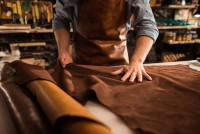Black split velour for lining and upper leather: This article meets the challenging requirements in wet-end, dyeing and retanning processing.
This often requested article provides some of the most challenging requirements in wet-end, dyeing and retanning processing, such as:
- Deep uniform shade
- High migration fastness
- Good rubbing fastness in dry and wet
- Good perspiration fastness
- Good washing fastness
- High light fastness
To achieve these requirements we use the new SELLA HiFA system in a modified 2-step process. Important is to minimise the use of anionic retanning and fatliquoring agents in the crusting step, in order to allow the build up and fixation of the SELLA HiFA system in the subsequent process.
The main problem is to ensure good removal of the buffing dust before the first dyestuff addition. Therefore one anionic and one cationic washing process start the dyeing procedure. After the application of the 3 step SELLA HiFA system (SELLA HiFA Pre, SELLA HiFA Bond, SELLA HiFA Black), the washing processes are extremely important in order to avoid the transportation of unbound dyestuff through the later processes. To achieve the high rubbing fast properties it is important to prevent a classical fixation of the unbound dyestuff after the SELLA HiFA treatment. Therefore the washing processes and the second treatment with SELLA HiFA Pre and SELLA HiFA Bond are necessary.
The fatliquoring can strongly influence the intensity of shade and the fastness properties. For moisture regulation and excellent washability, a combination of CORIPOL BZN, MAGNOPAL SOF and EUPILON WAS-1 was used.
The metal salt fixation is used to optimise the fixation of the washable fatliquoring agents and not necessarily to achieve certain water resistance.
As the final top fatliquoring, a combination of EULINOL TMS and RODA MOD 2081 is applied. This treatment intensifies the shade and adds additional surface handle to the velour. This after-treatment can also help to improve the dry and wet rubbing fastness properties and the gloss of the nap.
If trials are done with the SELLA HiFA system it can be noticed that the wet crust leather can be handled much easier through the mechanical operations like setting out and vacuum drying compared to conventionally dyed black leather.
The excellent fixation helps to keep machinery and hands cleaner. This can be observed also when the leather is unloaded from the drum and horsed up.
To check the effectiveness of the SELLA HiFA system try a simple hand washing test with normal soap under warm water. A washing test comparison to conventionally dyed black leather can also be carried out on the dry crust leather.
Procesos
Industrias


 Automoción La sostenibilidad y la producción respetuosa con el medio ambiente, se han convertido en criterios importantes para los fabricantes de automóviles, sin embargo, las definiciones varían. Uno de los resultados es que los coches más livianos podrían reducir las emisiones de CO2 y de efecto invernadero. Tome el camino hacia la reducción de peso con los productos químicos TFL para cuero automotriz.
Automoción La sostenibilidad y la producción respetuosa con el medio ambiente, se han convertido en criterios importantes para los fabricantes de automóviles, sin embargo, las definiciones varían. Uno de los resultados es que los coches más livianos podrían reducir las emisiones de CO2 y de efecto invernadero. Tome el camino hacia la reducción de peso con los productos químicos TFL para cuero automotriz.
 Tapicería Las pieles de cuero para tapicería deben ser tan versátiles como sus productos finales. Blanda, lisa con un agradable tacto suave, resistente a la suciedad con perfectas capacidades de protección física. Sea cual sea su característica, la piel es la elección perfecta para artículos de tapicería.
Tapicería Las pieles de cuero para tapicería deben ser tan versátiles como sus productos finales. Blanda, lisa con un agradable tacto suave, resistente a la suciedad con perfectas capacidades de protección física. Sea cual sea su característica, la piel es la elección perfecta para artículos de tapicería. Calzado TFL ofrece los productos adecuados para cualquier tipo de cuero para la parte superior del calzado. Cueros robustos, gruesos y muy resistentes al agua o al desgarro o finos y ligeros con óptimas capacidades físicas y producidos cumpliendo con los más altos estándares en materia de sustancias peligrosas.
Calzado TFL ofrece los productos adecuados para cualquier tipo de cuero para la parte superior del calzado. Cueros robustos, gruesos y muy resistentes al agua o al desgarro o finos y ligeros con óptimas capacidades físicas y producidos cumpliendo con los más altos estándares en materia de sustancias peligrosas.
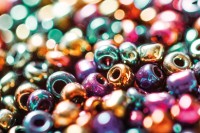

 Main Reaction - El blog de TFL Historias, incidentes, consejos y hechos en torno a los temas de cuero, química, moda, sostenibilidad y ecología. Nuestro equipo editorial, formado por curtidores experimentados, científicos, expertos en el mercado, especialistas en moda y comunicación, ha afilado sus lápices y le proporcionará contenido nuevo e inspirador de forma regular.
Main Reaction - El blog de TFL Historias, incidentes, consejos y hechos en torno a los temas de cuero, química, moda, sostenibilidad y ecología. Nuestro equipo editorial, formado por curtidores experimentados, científicos, expertos en el mercado, especialistas en moda y comunicación, ha afilado sus lápices y le proporcionará contenido nuevo e inspirador de forma regular.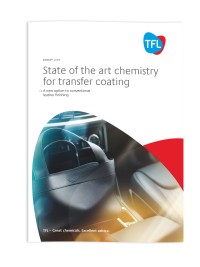 RODA® Line para recubrimientos por transferencia Recientemente, el recubrimiento por transferencia del cuero ha ganado una importancia significativa y está a punto de captar una parte sustancial del mercado actual de acabado. Esta tendencia se debe principalmente a las ventajas tecnológicas que ofrece la tecnología de recubrimiento por transferencia RODA® Line de TFL.
RODA® Line para recubrimientos por transferencia Recientemente, el recubrimiento por transferencia del cuero ha ganado una importancia significativa y está a punto de captar una parte sustancial del mercado actual de acabado. Esta tendencia se debe principalmente a las ventajas tecnológicas que ofrece la tecnología de recubrimiento por transferencia RODA® Line de TFL.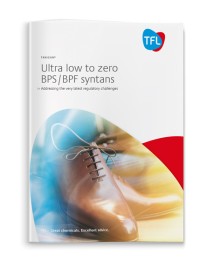
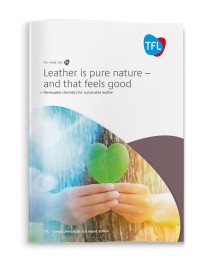
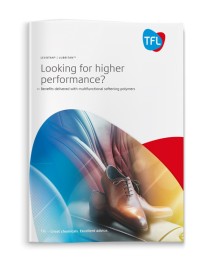
 Nuestra compañía TFL es una empresa que opera a nivel mundial que produce productos químicos especiales para la industria del cuero e industrias relacionadas. TFL ofrece sus productos y soluciones innovadores a curtiembres, empresas de procesamiento de cuero y coaters, siempre esforzándose por introducir ideasnuevas en el mercado.
Nuestra compañía TFL es una empresa que opera a nivel mundial que produce productos químicos especiales para la industria del cuero e industrias relacionadas. TFL ofrece sus productos y soluciones innovadores a curtiembres, empresas de procesamiento de cuero y coaters, siempre esforzándose por introducir ideasnuevas en el mercado.



